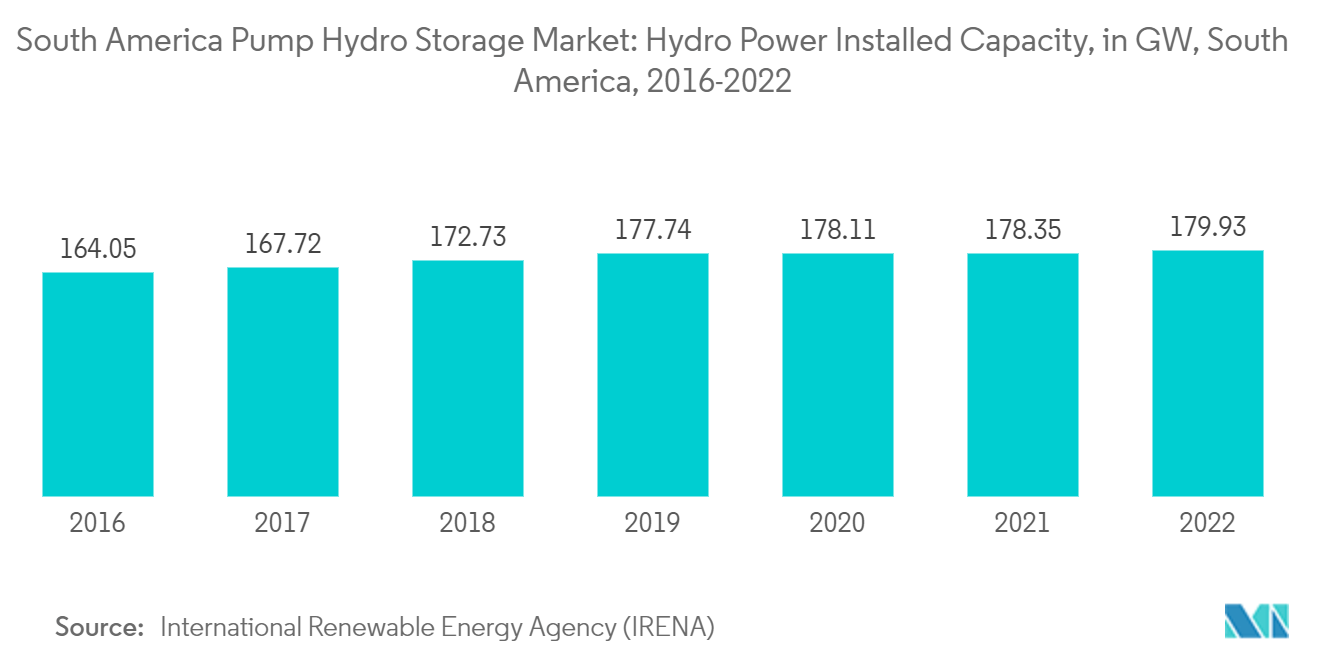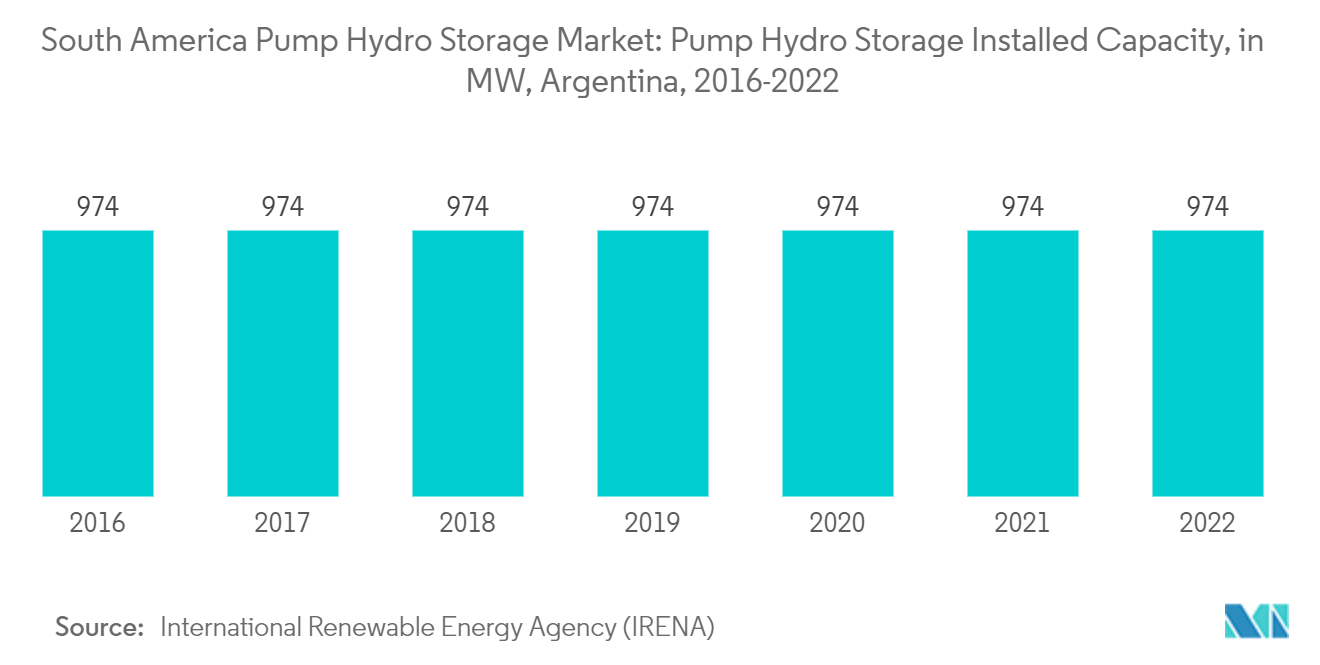Market Trends of South America Pumped Hydro Storage Industry
Closed-loop is Expected to Dominate the Market
- The closed-loop pump hydro storage system is anticipated to experience notable growth in the South American market, driven by several strategic factors that underscore the region's evolving energy landscape. One of the key drivers is the increasing emphasis on renewable energy sources, mainly hydropower, as South America boasts abundant water resources. Closed-loop systems, characterized by their closed-circuit design, offer an efficient means of harnessing and storing energy, aligning well with the continent's commitment to sustainable energy practices.
- According to the International Renewable Energy Agency, hydropower installation has increased significantly in the region in the past few years. Between 2016 and 2022, the growth rate in capacity addition was recorded at around 10%, signifying the increasing adoption of hydropower, which in turn can drive the demand for pump storage.
- Furthermore, the inherent flexibility of closed-loop pump hydro storage positions it as a reliable solution for managing the intermittency associated with renewable energy generation. As South American countries continue to integrate diverse renewable sources like wind and solar into their energy portfolios, the need for adequate energy storage becomes paramount. Closed-loop systems contribute significantly to grid stability and reliability due to their ability to store excess energy during periods of low demand and release it during peak demand.
- The regulatory landscape also plays a crucial role in driving the growth of closed-loop pump hydro storage in South America. Governments across the region are increasingly recognizing the importance of energy storage solutions in achieving energy security and sustainability goals. Supportive policies and incentives aimed at promoting closed-loop pump hydro storage projects create a conducive environment for investments, driving the market's expansion.
- For instance, in May 2022, GE Renewable Energy's Hydro and Grid Solutions divisions collaboratively entered a contract for the technological enhancement of the Itaipu hydropower plant situated in Brazil and Paraguay, ranking as the world's second-largest. Oversight of the upgrade project for this 14 GW installed capacity power plant on the Paraná River, shared between Brazil and Paraguay, falls under the purview of a consortium led by GE Hydro Solutions.
- Additionally, the scalability of closed-loop pump hydro storage systems aligns with the region's evolving energy requirements. The modular nature of these systems allows for flexible capacity additions, enabling stakeholders to adapt to changing energy demand dynamics. This scalability factor is particularly significant in the context of South America's diverse energy needs and the potential for cross-border energy trading.
- Therefore, as per the points mentioned above, the closed-loop segment is expected to dominate the market during the forecast period.

Argentina is Expected to Dominate the Market
- The increasing focus on renewable energy sources, including hydropower, aligns seamlessly with the attributes of pump hydro storage. As Argentina strives to diversify its energy mix and reduce dependency on traditional fossil fuels, the versatility and reliability of pump hydro storage emerge as pivotal components in ensuring a sustainable and resilient energy infrastructure.
- The abundant hydropower potential in Argentina further solidifies the growth prospects for pump hydro storage. With a vast array of water resources at its disposal, the country possesses an ideal environment for the development of pump hydro storage projects. These projects can leverage existing hydroelectric infrastructure, contributing not only to energy storage but also enhancing the overall efficiency and productivity of the nation's hydropower resources.
- Moreover, Argentina is the leading country in the installed capacity pump hydro storage. According to the International Renewable Energy Agency, as of 2022, the country had about 974 MW of pump hydro storage capacity, with two pump hydro storage projects of an installed capacity of about 750 MW and another capacity of 224 MW.
- The evolving regulatory landscape and government support for renewable energy initiatives play a crucial role in shaping the trajectory of pump hydro storage in Argentina. The government's commitment to fostering sustainable energy practices, coupled with incentives and policies aimed at promoting energy storage solutions, creates a conducive environment for the growth of pump hydro storage projects. This support is instrumental in attracting investments and driving the implementation of such projects within the country.
- For instance, in September 2023, the province of Córdoba in Argentina initiated a tender process for a USD 100 million contract aimed at refurbishing a 750 MW pumped storage hydropower plant. The goal is to revitalize the Rio Grande facility, currently operating at approximately half of its designated capacity, and restore its full production potential. Epec, the publicly owned energy company of Córdoba, is spearheading the tender process and overseeing the operation of the plant. The proposed refurbishment works are anticipated to span five years, with the objective of extending the lifespan of the Rio Grande plant by a minimum of 40 years.
- Moreover, the growing need for grid stability and reliability provides a compelling case for the adoption of pump hydro storage in Argentina. As the country experiences shifts in energy demand and incorporates a more significant share of intermittent renewable sources, the ability of pump hydro storage to act as a stabilizing force on the grid becomes increasingly valuable. The technology's capacity to store excess energy during periods of low demand and release it during peak demand aligns with the nation's requirements for a flexible and resilient energy system.
- Therefore, as per the points mentioned above, the country is expected to witness significant growth during the forecast period.


